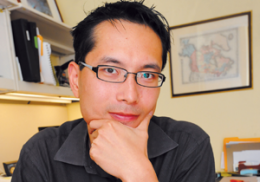Columbia engineer designs handheld device used to diagnose illness

(PhysOrg.com) -- Bioengineer Samuel Sia has designed a handheld device which uses a microchip to perform intricate medical tests for illnesses such as sexually transmitted diseases or prostate cancer. It needs just a drop of blood to diagnose a patient, and results come back in 12 to 15 minutes. This lab-on-a-chip method miniaturizes and simplifies the once time-consuming system of analyzing diagnostic tests results.
It used to be that villagers in the developing world had to go to a lab to find out if they were positive for HIV and other diseases. Bioengineer Samuel Sia has figured out a way to take the lab to the village.
Called mChip, the handheld device uses a microchip to perform intricate medical tests for illnesses such as sexually transmitted diseases or prostate cancer. It needs just a drop of blood to diagnose a patient, and results come back in 12 to 15 minutes. This lab-on-a-chip method miniaturizes and simplifies the once time-consuming system of analyzing diagnostic tests results.
“We are engineering a credit card-sized device that can produce blood-based diagnostic results in minutes. The idea is to make a large class of diagnostic tests accessible to patients in any setting in the world, rather than forcing them to go to a clinic to draw blood and then wait days for their results,” said Sia, an assistant professor of biomedical engineering who has been at Columbia for five years.
The idea for the device came to Sia in 2001, when he spent a month in a remote village in Togo, a small country in West Africa. There was no access to electricity or running water. “It was eye-opening,” he said. “I saw a lot of the needs of the people there firsthand … A child in my village died from tetanus, which is a completely preventable disease.”
Sia was a Ph.D candidate at Harvard at the time, but the experience stuck with him. When he decided to pursue biomedical engineering as his specialty, he chose to focus on ways to deliver health care to developing countries using his skills as a scientist and engineer.
The mChip has been tested in Rwanda for the past four years in partnership with the Mailman School of Public Health’s International Center for AIDS Care and Treatment Programs. The microchip inside the device is similar to that of a computer chip, said Sia, and the cost of the instrument is about $100.
Sia and his lab in Columbia’s biomedical engineering department are focusing on pregnant women who may have HIV/AIDS and sexually transmitted diseases but cannot be tested due to their remote location. The hope is to get these devices in the hands of health care workers in developing countries where access is critical.
“Diagnosis of infectious diseases is very important in the developing world in general, but especially for pregnant women because they can pass these STDs on to their newborns,” said Sia, 34. “When you’re in these villages, you may have the drugs for many STDs, but you don’t know who to give treatments to, so the challenge really comes down to diagnostics.”
In August, Sia was named one of the world’s top young innovators for 2010 by MIT’s Technology Review for his work in biotechnology and medicine. In 2008, he received a career award from the National Science Foundation, which included a $400,000 grant to support his other research specialty in three-dimensional tissue engineering.
A version of the mChip that tests for prostate cancer has been developed by Sia’s lab and Claros Diagnostics Inc., a company he co-founded in 2004, and has been approved for use in Europe.
The next step, he says, is making sure that those test results are acted upon quickly. Sia’s lab has recently found a way to integrate a mobile communications component into the mChip. In Rwanda, where more than 40,000 patients have electronic health records, the mChip can automatically send test results for inclusion in those records via a cell phone chip or satellite. That, in turn, can help ensure the results will quickly lead to a treatment plan.
As he thinks about new research ideas and projects, Sia often goes back to this fundamental question: What is needed to improve human health?
“We as scientists and engineers have a lot of technical skills,” said Sia. “We know how to run experiments. We know what technologies are available. The most challenging part is trying to identify what the real problem is.”




















